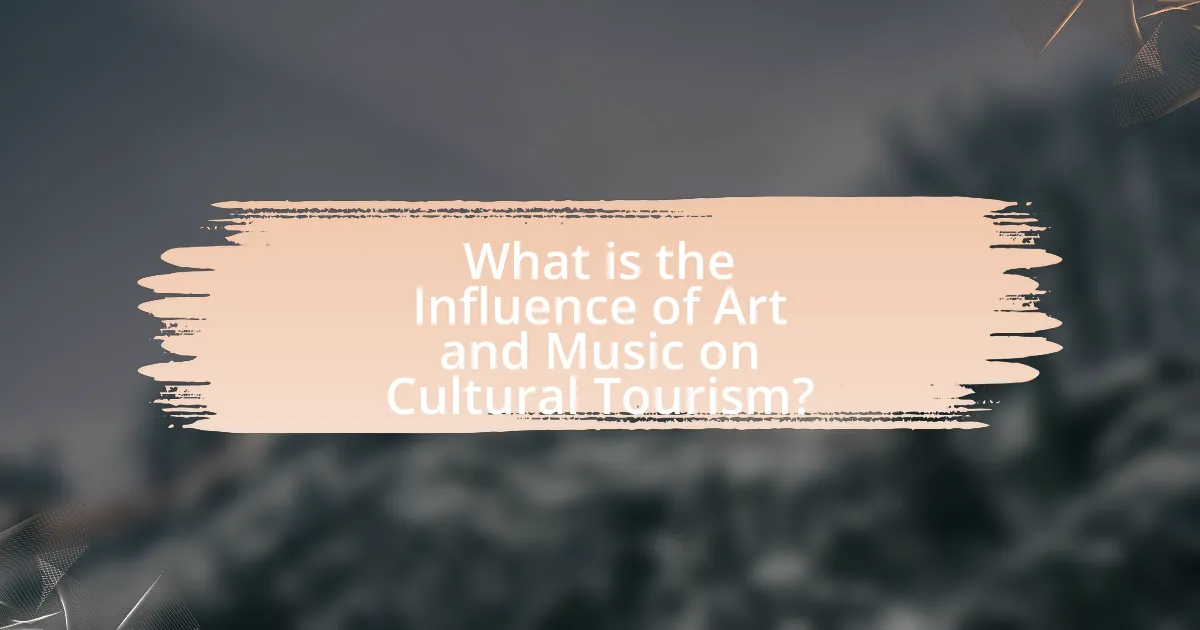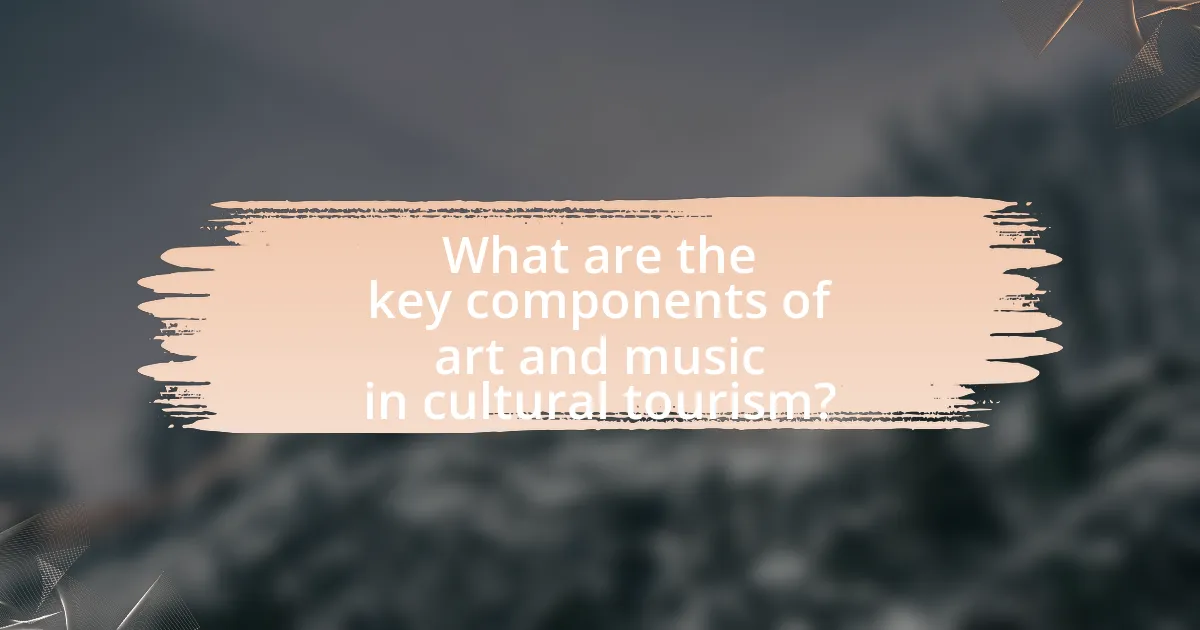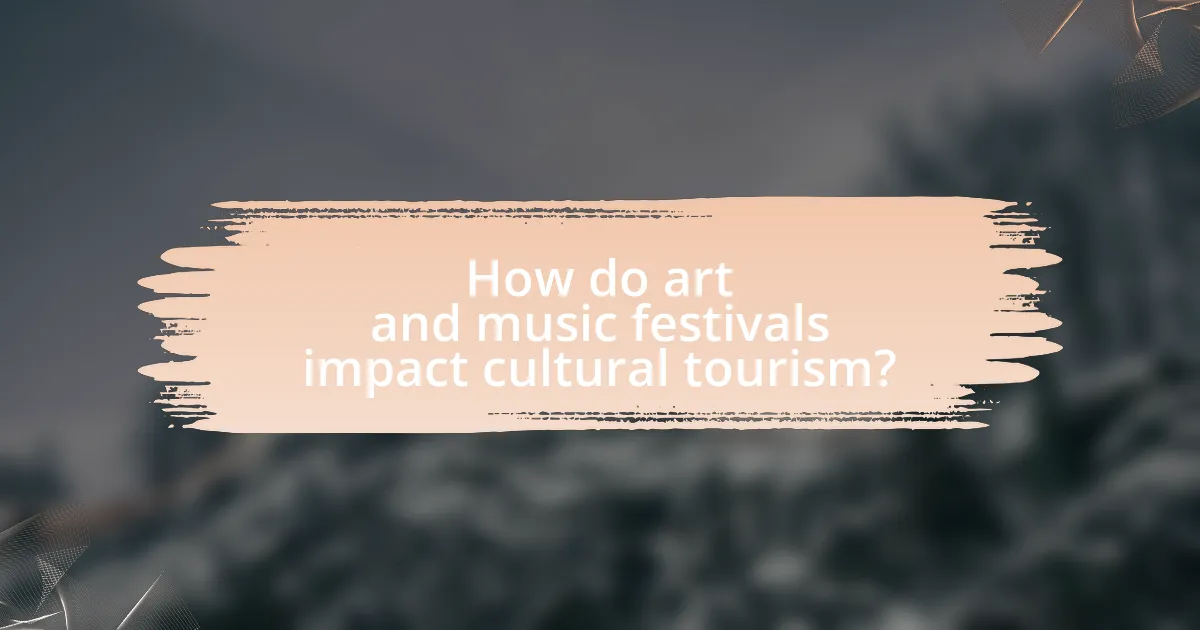The article examines the influence of art and music on cultural tourism, highlighting their role in enhancing destination attractiveness and enriching visitor experiences. It discusses how cultural tourists seek authentic encounters, with art and music providing insights into local traditions and identities. Key components include the economic benefits of art and music festivals, the impact of local art on tourist engagement, and the importance of integrating these cultural elements to foster community involvement and preserve cultural heritage. The article also addresses challenges such as commercialization and sustainability, offering strategies for stakeholders to enhance the cultural tourism landscape.

What is the Influence of Art and Music on Cultural Tourism?
Art and music significantly influence cultural tourism by enhancing the attractiveness of destinations and enriching visitor experiences. Cultural tourists often seek authentic experiences, and art and music provide a unique insight into local traditions, history, and identity. For instance, UNESCO recognizes various cultural events and heritage sites, such as the Carnival of Venice and the Sydney Opera House, which draw millions of visitors annually, showcasing how artistic expressions can drive tourism. Additionally, studies indicate that destinations with vibrant art scenes and music festivals see increased visitor spending and longer stays, demonstrating the economic impact of these cultural elements on tourism.
How do art and music shape cultural tourism experiences?
Art and music significantly shape cultural tourism experiences by enhancing emotional connections and providing authentic cultural insights. Art, such as local paintings and sculptures, allows tourists to engage with the history and identity of a destination, while music, including traditional performances and local genres, creates immersive experiences that resonate with visitors. For instance, UNESCO recognizes the importance of cultural heritage, noting that art and music contribute to the preservation of local traditions, which in turn attracts tourists seeking genuine cultural interactions. Additionally, studies show that destinations with vibrant art scenes and music festivals see increased tourist engagement and satisfaction, as these elements foster a deeper appreciation for the local culture.
What role does local art play in attracting tourists?
Local art plays a significant role in attracting tourists by enhancing the cultural experience and providing unique, authentic encounters that differentiate destinations. Tourists are drawn to locations where they can engage with local art forms, such as traditional crafts, visual arts, and performances, which reflect the region’s heritage and identity. For instance, a study by the National Endowment for the Arts found that 72% of travelers are more likely to visit a destination that offers local art events or exhibitions. This engagement not only enriches the visitor experience but also supports local economies by promoting art-related tourism activities, such as gallery tours and art festivals.
How does music influence the perception of cultural destinations?
Music significantly influences the perception of cultural destinations by enhancing emotional connections and creating immersive experiences for visitors. Research indicates that music can evoke specific emotions and memories, which in turn shapes how individuals perceive and engage with a cultural site. For instance, a study published in the Journal of Travel Research found that background music in museums can enhance visitor satisfaction and increase the time spent at exhibits, thereby deepening the overall cultural experience. Additionally, local music styles can reflect the identity and heritage of a destination, making it more appealing to tourists seeking authentic experiences. This interplay between music and cultural perception underscores the importance of auditory elements in shaping the attractiveness and memorability of cultural tourism.
Why is the integration of art and music important in cultural tourism?
The integration of art and music is important in cultural tourism because it enhances the overall visitor experience and fosters a deeper connection to local cultures. Art and music serve as vital expressions of cultural identity, allowing tourists to engage with the history, traditions, and values of a destination. For instance, UNESCO recognizes the role of cultural heritage in tourism, noting that cultural experiences, including art and music, significantly influence travelers’ choices and satisfaction levels. This integration not only attracts visitors but also supports local economies by promoting cultural events and artistic initiatives, thereby sustaining the cultural landscape.
What benefits do art and music bring to cultural tourism?
Art and music enhance cultural tourism by attracting visitors, enriching their experiences, and fostering community engagement. These creative expressions serve as key motivators for travel, with studies indicating that 78% of cultural tourists prioritize art and music events when choosing destinations. Additionally, art and music contribute to the local economy through increased spending on tickets, merchandise, and hospitality services. For instance, the economic impact of music festivals can reach millions, as seen with events like Coachella, which generates over $700 million annually for the local economy. Furthermore, art and music promote cultural exchange, allowing tourists to connect with local traditions and communities, thereby deepening their understanding and appreciation of the destination.
How do art and music enhance the authenticity of cultural experiences?
Art and music enhance the authenticity of cultural experiences by providing a tangible expression of a community’s identity and values. These forms of creative expression reflect the historical, social, and emotional contexts of a culture, allowing visitors to engage with the local heritage in a meaningful way. For instance, traditional music often incorporates local dialects and instruments, which can evoke a sense of place and belonging, while visual art can depict cultural narratives and historical events that resonate with the community’s collective memory. Studies have shown that cultural tourism experiences that include local art and music significantly increase visitor satisfaction and connection to the destination, as evidenced by research from the World Tourism Organization, which highlights that 70% of tourists seek authentic cultural experiences that include local artistic expressions.

What are the key components of art and music in cultural tourism?
The key components of art and music in cultural tourism are authenticity, local engagement, and experiential learning. Authenticity ensures that the art and music reflect the true cultural identity of a destination, attracting tourists seeking genuine experiences. Local engagement involves the participation of local artists and musicians, fostering community pride and providing visitors with unique insights into the culture. Experiential learning allows tourists to actively participate in artistic and musical activities, enhancing their understanding and appreciation of the local culture. These components collectively enrich the cultural tourism experience, as evidenced by studies showing that destinations with vibrant art and music scenes see increased visitor satisfaction and longer stays.
What types of art are most influential in cultural tourism?
Visual arts, performing arts, and traditional crafts are the most influential types of art in cultural tourism. Visual arts, including painting and sculpture, attract tourists to museums and galleries, significantly contributing to local economies; for instance, the Louvre in Paris draws millions of visitors annually. Performing arts, such as theater and music festivals, create immersive cultural experiences that enhance tourism; events like the Edinburgh Festival Fringe showcase diverse performances and attract global audiences. Traditional crafts, representing local heritage, engage tourists through workshops and markets, fostering cultural exchange and appreciation. These art forms collectively enhance the cultural tourism landscape by promoting local identity and generating economic benefits.
How do visual arts contribute to the cultural identity of a destination?
Visual arts significantly contribute to the cultural identity of a destination by embodying its history, values, and traditions. They serve as a visual representation of the local culture, allowing residents and visitors to connect with the unique characteristics of the area. For instance, murals and sculptures often reflect the community’s heritage, telling stories that resonate with both locals and tourists. In cities like Florence, Italy, the Renaissance art movement is a cornerstone of its identity, attracting millions of visitors annually who seek to experience its rich artistic legacy. This connection between visual arts and cultural identity not only enhances tourism but also fosters a sense of pride among residents, reinforcing the destination’s unique place in the global cultural landscape.
What impact do performing arts have on tourist engagement?
Performing arts significantly enhance tourist engagement by providing immersive cultural experiences that attract visitors. These artistic expressions, such as theater, dance, and music, create unique opportunities for tourists to connect with local traditions and communities. For instance, a study by the World Tourism Organization found that cultural events, including performances, can increase tourist spending by up to 30%, as they often lead to longer stays and higher expenditure on related activities. Additionally, festivals featuring performing arts draw large crowds, fostering social interactions among tourists and locals, which further enriches the travel experience.
What types of music are significant in cultural tourism?
Significant types of music in cultural tourism include traditional folk music, classical music, and contemporary genres such as jazz and world music. Traditional folk music often reflects the cultural heritage and identity of a region, attracting tourists interested in authentic experiences. For example, the folk music of Ireland, characterized by instruments like the fiddle and bodhrán, draws visitors to festivals and local performances. Classical music, exemplified by the works of composers like Mozart in Austria, plays a crucial role in cultural tourism, with events such as the Salzburg Festival showcasing this genre. Additionally, contemporary genres like jazz, particularly in cities like New Orleans, and world music, which encompasses diverse styles from various cultures, significantly enhance the cultural tourism experience by offering unique musical landscapes that resonate with visitors.
How does traditional music reflect the culture of a region?
Traditional music reflects the culture of a region by embodying its historical narratives, social values, and communal practices. For instance, folk songs often narrate local legends or historical events, preserving the collective memory of the community. Additionally, traditional music incorporates local instruments and styles that are unique to the region, showcasing its cultural identity. Research indicates that music serves as a medium for cultural expression, with studies highlighting how specific musical forms, such as the Irish jig or the African drum, are deeply intertwined with the social and cultural fabric of their respective communities. This connection between music and culture enhances cultural tourism by attracting visitors interested in authentic cultural experiences.
What role does contemporary music play in attracting younger tourists?
Contemporary music plays a significant role in attracting younger tourists by creating vibrant cultural experiences that resonate with their interests. Events such as music festivals, live performances, and local music scenes serve as key attractions, drawing younger demographics who seek immersive and engaging activities. For instance, a report by the International Music Summit in 2021 highlighted that 70% of millennials prioritize music events when choosing travel destinations, indicating a strong correlation between contemporary music and tourism appeal among younger audiences.

How do art and music festivals impact cultural tourism?
Art and music festivals significantly enhance cultural tourism by attracting visitors who seek unique cultural experiences. These festivals serve as platforms for showcasing local traditions, art forms, and musical genres, thereby promoting regional identity and heritage. For instance, events like the Edinburgh Festival Fringe and Coachella not only draw large crowds but also stimulate local economies through increased spending on accommodations, food, and transportation. According to a study by the National Endowment for the Arts, cultural events can lead to a 20% increase in tourism in host cities, demonstrating their substantial impact on attracting tourists and fostering cultural exchange.
What are the economic benefits of art and music festivals for local communities?
Art and music festivals provide significant economic benefits to local communities by driving tourism, increasing local spending, and creating jobs. These festivals attract visitors who spend money on accommodations, food, transportation, and local attractions, which stimulates the local economy. For instance, a study by the National Endowment for the Arts found that arts festivals can generate millions in revenue for host cities, with some events reporting a return on investment of up to $4 for every $1 spent. Additionally, these festivals often require local staffing, leading to job creation in various sectors, including hospitality and retail. Overall, the influx of visitors and the associated spending contribute to the economic vitality of local communities.
How do festivals promote cultural exchange among tourists?
Festivals promote cultural exchange among tourists by providing immersive experiences that showcase diverse traditions, art forms, and culinary practices. These events often feature performances, workshops, and exhibitions that allow tourists to engage directly with local cultures, fostering understanding and appreciation. For example, the Edinburgh Festival Fringe attracts over 3 million visitors annually, offering a platform for artists from around the world to share their work, thereby facilitating cross-cultural dialogue and interaction. This exchange not only enriches the tourist experience but also supports local economies and cultural preservation.
What challenges do art and music face in cultural tourism?
Art and music face several challenges in cultural tourism, primarily including commercialization, cultural appropriation, and sustainability. Commercialization often leads to the dilution of authentic artistic expressions as local artists may alter their work to cater to tourist preferences, undermining cultural integrity. Cultural appropriation occurs when elements of a culture are used without understanding or respect, which can alienate local communities and diminish the value of their art and music. Additionally, sustainability poses a challenge as increased tourist traffic can strain local resources and disrupt traditional practices, threatening the longevity of cultural expressions. These challenges highlight the need for a balanced approach that respects and preserves the authenticity of art and music within cultural tourism.
How can cultural tourism stakeholders address these challenges?
Cultural tourism stakeholders can address challenges by fostering collaboration among local communities, artists, and tourism operators. This collaboration can enhance the authenticity of cultural experiences, ensuring that they reflect the true essence of the local culture. For instance, initiatives like community-led festivals or art exhibitions can engage local artists and promote cultural heritage, which has been shown to increase visitor satisfaction and retention. According to a study by the World Tourism Organization, destinations that actively involve local communities in tourism planning see a 20% increase in visitor engagement and a 15% rise in economic benefits for those communities. By prioritizing sustainable practices and cultural preservation, stakeholders can effectively mitigate the negative impacts of tourism while enriching the cultural landscape.
What best practices can enhance the influence of art and music on cultural tourism?
Integrating local art and music into cultural tourism enhances visitor engagement and experience. Best practices include collaborating with local artists and musicians to create authentic cultural experiences, which fosters a deeper connection between tourists and the destination. For instance, cities like New Orleans leverage their unique musical heritage through festivals and live performances, attracting millions of visitors annually. Additionally, promoting art installations and exhibitions that reflect local culture can draw tourists, as seen in cities like Florence, where art is a central aspect of the tourism experience. Furthermore, utilizing digital platforms to showcase local art and music can reach a broader audience, increasing interest and visitation. These practices not only enrich the cultural tourism landscape but also support local economies and preserve cultural heritage.
How can destinations effectively market their art and music offerings?
Destinations can effectively market their art and music offerings by leveraging digital platforms, engaging local artists, and creating immersive experiences. Digital platforms, such as social media and dedicated tourism websites, allow destinations to showcase their art and music events to a broader audience, increasing visibility and attracting tourists. Engaging local artists in promotional campaigns not only highlights authentic cultural experiences but also fosters community involvement, which can enhance the destination’s appeal. Additionally, creating immersive experiences, such as art walks or music festivals, allows visitors to engage with the local culture firsthand, making the offerings more memorable and encouraging word-of-mouth promotion. According to a study by the National Endowment for the Arts, cultural events significantly boost tourism, with 72% of travelers indicating that they seek out arts and culture when visiting new places.
What strategies can be implemented to foster community involvement in cultural tourism?
To foster community involvement in cultural tourism, strategies such as engaging local artists, organizing cultural festivals, and promoting community-led tours can be implemented. Engaging local artists ensures that cultural expressions are authentic and resonate with both residents and visitors, as evidenced by the success of initiatives like the “Art in the Park” program in various cities, which showcases local talent and attracts tourists. Organizing cultural festivals, such as the annual “Folk Festival” in many regions, encourages participation from community members and highlights local traditions, drawing in tourists and enhancing cultural exchange. Promoting community-led tours allows residents to share their unique stories and heritage, as seen in programs like “Local Guides” in cities worldwide, which not only enrich the visitor experience but also empower locals economically and socially.